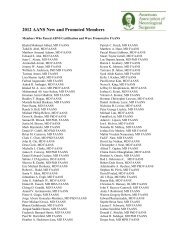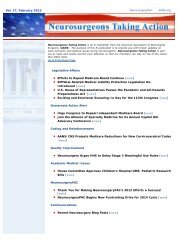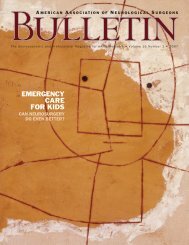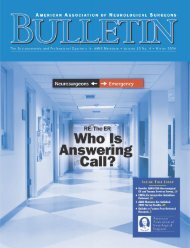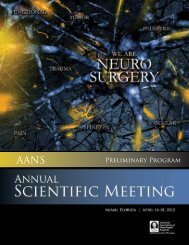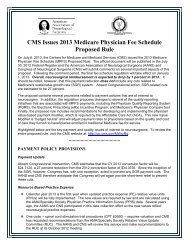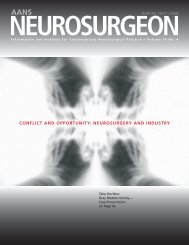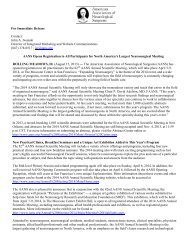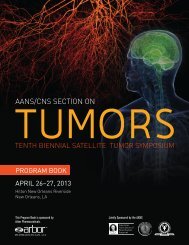view PDF - American Association of Neurological Surgeons
view PDF - American Association of Neurological Surgeons
view PDF - American Association of Neurological Surgeons
You also want an ePaper? Increase the reach of your titles
YUMPU automatically turns print PDFs into web optimized ePapers that Google loves.
CMANDA J. SEAVER<br />
COMPLETING THE<br />
AANS 2006 Workforce Survey Assesses Neurosurgical<br />
Completing the picture <strong>of</strong> neurosurgical emergency coverage in the<br />
United States is the aim <strong>of</strong> a new survey conducted by the <strong>American</strong><br />
<strong>Association</strong> <strong>of</strong> <strong>Neurological</strong> <strong>Surgeons</strong>. The AANS 2006 Workforce<br />
Survey shows that while the overall participation <strong>of</strong> neurosurgeons<br />
in the nation’s emergency medical system remains strong, there is<br />
room for improvement in neurosurgical call coverage and, more<br />
broadly, in the emergency medical system itself.<br />
The emergency medical system has been the subject <strong>of</strong> intense<br />
scrutiny, most recently by the Institute <strong>of</strong> Medicine which released<br />
three reports June 14 that conjure an image <strong>of</strong> an unraveling system.<br />
The three reports—Emergency Care for Children: Growing Pains,<br />
Emergency Medical Services at the Crossroads, and Hospital-Based<br />
Emergency Care: At the Breaking Point—depict what the IOM characterizes<br />
as an “overburdened, underfunded, and highly fragmented”<br />
U.S. emergency medical system.<br />
The IOM reports are the product <strong>of</strong> the Committee on the<br />
Future <strong>of</strong> Emergency Care in the U.S. Health System, a group commissioned<br />
in September 2003 to perform extensive study <strong>of</strong> emergency<br />
care issues. In announcing the reports, committee chair Gail<br />
L. Warden observed that “the system’s capacity is not keeping pace<br />
with the increasing demands being placed on it” and called for “a<br />
comprehensive effort to shore up America’s emergency medical care<br />
resources and fix problems that can threaten the health and lives <strong>of</strong><br />
people in the midst <strong>of</strong> a crisis.”<br />
Inadequate reimbursement, increased liability, and unintended<br />
consequences <strong>of</strong> the Emergency Medical Treatment and Labor Act,<br />
all cited in the IOM report on hospital-based care as factors contributing<br />
to inadequate coverage by specialists in the ER, have been<br />
among organized neurosurgery’s premier concerns in recent years.<br />
These issues were also among the threads comprising the complex<br />
fabric that characterizes the delivery <strong>of</strong> emergency neurosurgical<br />
care, described by Alex Valadka, MD, in the cover story <strong>of</strong> the Winter<br />
2004 Bulletin. Also in that issue, results <strong>of</strong> the 2004 AANS/CNS<br />
Neurosurgical ER and Trauma Services Survey were released.<br />
The 2004 ER survey was clear in its finding that a solid majority,<br />
83 percent, <strong>of</strong> neurosurgeons or their practices were providing full<br />
(24/7/365) emergency coverage. However, as summarized in the<br />
“Portion <strong>of</strong> a Hanging Showing a Figure <strong>of</strong> a Warrior.” See page 1 for details.<br />
Bulletin by AANS Executive Committee member James R. Bean,<br />
MD, the survey also showed that “some neurosurgeons [were]<br />
straining to provide emergency coverage, particularly those in private<br />
practice and in small group settings, and that some patients,<br />
particularly trauma victims and children distant from a level 1 trauma<br />
center, may be at risk for not receiving timely and appropriate<br />
neurosurgical emergency care.”<br />
That neurosurgeons were interested in and concerned about<br />
neurosurgical emergency coverage was demonstrated by the 2004<br />
survey’s robust response rate <strong>of</strong> 32 percent, coupled with the more<br />
than 350 comments <strong>of</strong>fered and the more than half <strong>of</strong> respondents<br />
who volunteered themselves for follow-up discussion <strong>of</strong> neurosurgical<br />
emergency care in their areas.<br />
8 Vol. 15, No. 2 • 2006 • AANS Bulletin



